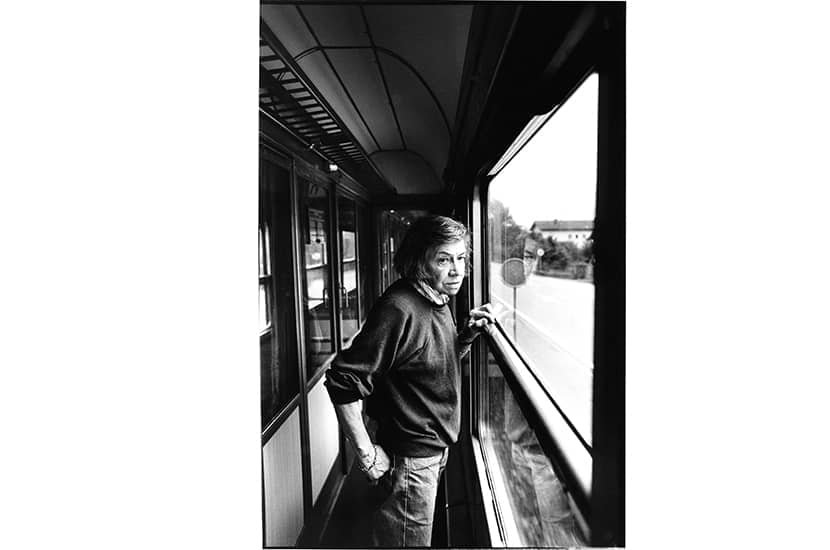There are three ways of knowing Patricia Highsmith. First, of course, she was the author of 22 novels and several story collections published between 1950 and 1995, the year of her death. Then the woman herself: Mary Patricia Plangman, born in Dallas in 1921, long-term resident of New York City, when young a socially and sexually active lesbian, later in life a mostly solitary literary figure in almost constant movement around Europe. Much biographical work has been written about her. And, finally, a revelation: she was the keeper of not only an intimate diary for most of those years, but also workbooks she called ‘cahiers’, all now published in a single volume.
Naturally there are only shades of difference between the three notional women, but each one illuminates the other two. Although the originals of the diaries have been available to scholars for some years, and have already been mined by biographers, for the interested reader this volume of previously unpublished material breaks new ground, providing us with a chance of glimpsing at last the real Patricia Highsmith.
The book, edited by Anna von Planta, runs to roughly 1,000 pages, with a great deal of comment, context-setting and notes. It is arranged chronologically, with the diaries and notebooks appearing together. The diaries are dated in American long form, M D Y, the notebooks in American numerical short form, M/D/Y. There is some overlap of content, but broadly speaking the diaries contain personal thoughts, experiences and dreams, while the notebooks are about books, literature and Highsmith’s own writing.
Although presented in English throughout, long parts of the originals were written in German or French, sometimes in Italian or Spanish. Highsmith’s use of these languages has been described as comprehensible if faulty, so we have to assume the translations here are accurate and sympathetic to the original.
The journals as written by Highsmith run to some 8,000 pages, and even allowing for the fact that one handwritten page does not equal a printed page, it is obvious this book consists of a selection. One immediately becomes interested in the role of the editor: what has been left out, what more is there, what was the reasoning behind the selection? For one example, in his book Patricia Highsmith, Beautiful Shadow (2003), the biographer Andrew Wilson mentions a notebook entry of 15 December 1964:
Fantasy, an unflagging optimism is necessary for a writer at all stages of this rough game. A kind of madness is therefore necessary, when there is every logical reason for a state of depression and discouragement… Perhaps the fact that I can react with utter gloom to this is what keeps me from being psychotic and keeps me merely neurotic… I am doing quite a good day’s work today. But I am also aware of the madness that actually sustains me, and I am not made more comfortable or happy by it.
To understand Highsmith’s dark side one should start by considering her relationship with her mother
This distinction between psychopathy and creative tension touches on a central subject in Highsmithian matters, but it is not in this book. Did she have more to say?
In the early days, when Highsmith was young and active in the NYC literary/artistic scene, most of the diary entries are about love and sex. She regularly fell in love with other women, passionately and demandingly; but within weeks the love of her life was replaced by another, a repeating cycle. At least one of these intense affairs led indirectly to a suicide — of the artist Allela Cornell, who died in horrific circumstances after drinking nitric acid. Familiar situations recurred: most of the participants were promiscuous, and Highsmith had a taste for slightly older women, especially if married or in long-term relationships. She also sometimes became involved with their male partners.
Names are often concealed or identified by an initial only. Presumably this is a result of revisions made in later years. Both the notebooks and the diaries were revisited by Highsmith, sometimes decades later, when she would make corrections, deletions and notes — she expected them to be published one day, and left instructions about that. Because at different times she discovered at least two of her female lovers were reading the diaries behind her back, she mostly discontinued them in later life, but the notebooks then contained more personal material.
Her views on lesbianism are open and candid, but she was living in a time when homosexuality was illegal and socially unacceptable. During this period she had two lasting relationships with men: the German photographer Rolf Tietgens, who became a loyal friend, and the novelist Marc Brandel, whom she met while staying at the Yaddo writers’ colony. For a time she was even engaged to Brandel. Because of him she voluntarily underwent psychoanalysis in search of a ‘cure’ for homosexuality: she reflected that at the end all she got out of it was a big bill.
Recurring subjects in the diaries are an impressive amount of alcohol, late nights, parties, dinners, toothache and dentistry, lust, money. Even at this early age Highsmith was a serious drinker, also a chain smoker. But in spite of what seems like a wild lifestyle she took her writing seriously from the start, and worked hard for several hours every day, as she did until the end of her life.
Reading page after page of these diaries leads to a dissenting conclusion. The endless sexual involvements of a young woman on the way to becoming a world-class novelist are undoubtedly of interest, but they are only of limited interest. The affairs comprise more than two thirds of this long book. The point is we recognise Highsmith as a writer of fiction, and that is what endures. We are concerned with that and want to know what she had to say about it. Novelists draw on personal experience to a lesser degree than most readers think, and in a different way.
The cahiers in this period are slightly more enlightening to the general reader, as they tend to reflect the serious or literary side of her life, but during this round of sexual conquests and alcohol most of the entries are brief comments, pensées, the sort of thing writers note down. There are few reliable insights into what made her the writer she became.

As Highsmith’s literary career grew, starting with Strangers on a Train (1950), her notebooks become of increasing relevance. From that point the book gains traction. We see the first seedlings appear of new novels and stories. She prints many of her poems. We learn that the nervousness about the lesbian theme of her second novel, The Price of Salt (1953, reissued as Carol in 1990), came as much from her literary agent as from herself. Strangers had been intended by Highsmith as a general novel, but the publishers marketed it as ‘suspense’. The agent expected resistance to an author perceived as switching genres so early in a career. The Price of Salt went to another publisher and sold a million copies as a dime paperback, but it was under the name ‘Claire Morgan’.
Mary Patricia Plangman was born nine days after her mother Mary divorced her father, Jay Plangman. During the pregnancy Mary drank turpentine in a dangerous attempt to abort. Patricia was brought up in dysfunction: her mother married Stanley Highsmith, but they were poor whites, conservative Texans, and Patricia was raised largely by her grandmother. An inveterate reader, by the time she went to Barnard College she was already well and deeply read. Although she says little directly about her childhood in her diaries, there are hints about its consequences everywhere. In her adult years her relationship with her mother was toxic, each of them writing astonishingly venomous letters, even after Mary developed Alzheimer’s and was confined to a nursing home.
Those seeking some understanding of what is said to be the dark side of Highsmith’s nature should start by considering her family background, especially the mother-daughter relationship. Many of Highsmith’s lovers were older than her, and according to the necessarily one-sided accounts in this book they soon became harshly critical of her. She records bitter fallings out, even while passion flared in the bedroom. And although she thought of herself as a liberal, she often shocked friends and colleagues with her racist and anti-Semitic remarks, especially in later years.
Conservatism was not the only trait in this complex and fascinating woman. She continued to attract admirers and lovers, many of whom described her as quiet, considerate, humorous, deeply intelligent and kind. She did, though, illegally transport her favoured pet snails across national borders. She secreted them inside her bra, an act I find cruel, grotesque and a little repulsive.
She was essentially a European writer, not, as American editors wished her to be, a modern practitioner of serial-killer thrillers or whodunits. Hers was the art that conceals art: a straightforward narrative flow, highly readable and enjoyable, open to irony, tightly plotted and surreptitiously full of quiet menace. Many of her murder plots are ambiguous. Her novel Those Who Walk Away (1967) is full of attempted murders, but not a single dead body. Typically an act of violence is bungled or accidental, or motivated by a wish to kill but with no certain outcome. Her work is unique, addictive and extremely hard to put down.
This lack of genre identity made her so well known internationally that the Americans could no longer sideline her. Even then, the notebooks record one astonishing editorial failure after another. Joan Kahn, at Harper & Co, consistently rejected her manuscripts or demanded time-consuming rewrites. Robert Gottlieb, an editorial legend at Simon & Schuster and Knopf, said A Dog’s Ransom (1972) should be revised as he found her style ‘pebbly’. He later rejected Edith’s Diary (1977) out of hand, because he complained it was neither a suspense novel nor a ‘straight’ one. In his 2016 memoirs Gottlieb does not even mention Highsmith, although for several years he was her editor.
In Britain, most of her early work was published by Heinemann. They clearly took on the books after American deals were set up, and their first editions look like it. They are for the most part dowdy and half-hearted in appearance, at the lower end of the mid-list, apparently aimed at public libraries. Highsmith stayed with them for two decades until she could stand it no more. From about 1967 she established an enduring professional relationship with the Swiss publisher Diogenes. Anna von Planta was her editor there from the 1980s.
All her novels are good to excellent —there are no duds, not even the one Highsmith herself said was no good (A Game for the Living, 1958). Her finest is unquestionably The Talented Mr Ripley (1955), but there are many highlights: The Tremor of Forgery (1969), Strangers on a Train, This Sweet Sickness (1960), as well as the stand-out Carol, a brave and beautifully written novel. She also wrote one of the best ever how-to books on writing: Plotting and Writing Suspense Fiction (1966, revised in 1981), which can be recommended not only to would-be suspense writers but to anyone interested in becoming a novelist. Writing was the work of a lifetime for Patricia Highsmith, and she knew her business.






Comments